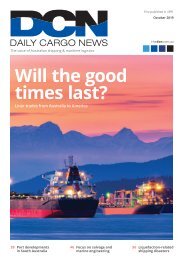DCN AUGUST Edition 2019
You also want an ePaper? Increase the reach of your titles
YUMPU automatically turns print PDFs into web optimized ePapers that Google loves.
MARITIME LAW<br />
IMO 2020 global sulphur cap<br />
and the Australian context<br />
Nic van der Reyden and Naraya Lamart of HFW examine the implications<br />
of IMO fuel sulphur content rules<br />
A 2008 AMENDMENT TO ANNEX VI<br />
of the International Convention for the<br />
Prevention of Pollution from Ships 1973 as<br />
modified by the Protocol of 1978 (together<br />
MARPOL) saw the International Maritime<br />
Organization adopt a new global cap for<br />
sulphur content in ship’s fuel oil of 0.5%,<br />
which is to come into force on January<br />
1, 2020. This is a significant reduction<br />
from the previous cap of 3.5% and will<br />
be implemented in Australia through the<br />
Protection of the Sea (Prevention of Pollution<br />
from Ships) Act 1983.<br />
As the implementation date draws near,<br />
the shipping world is still grappling with<br />
some of the implications.<br />
SUPPLY - IS THERE ENOUGH AND HOW<br />
MUCH WILL IT COST?<br />
Perhaps the most frequently discussed issue<br />
is whether there is going to be sufficient<br />
supply of low sulphur fuel oil, particularly<br />
in more remote regions, which would<br />
include Australia, due to Australia’s limited<br />
refining capacity and reliance on imported<br />
LSFO. It is also unclear whether refineries<br />
are prepared to prioritise production of<br />
LSFO and indeed whether they have the<br />
capacity to deal with production and<br />
storage as well as the logistical capabilities<br />
to deliver LSFO to ports and terminals<br />
around Australia.<br />
Local operators have been stockpiling<br />
LSFO to supply domestic vessels but many<br />
in the industry are questioning whether<br />
there will be enough LSFO to supply both<br />
vessels operating in Australia and those<br />
departing on international voyages. When<br />
considering Australia’s present freight task<br />
and its predicted growth in the next five<br />
years there is a justifiable concern as to<br />
whether there will be enough LSFO to meet<br />
demand on January 1, 2020 and in the<br />
years to come.<br />
The increase in the cost of feedstock<br />
that refineries use to produce LSFO as well<br />
as supply constraints will no doubt have<br />
an impact upon fuel pricing. Some predict<br />
this will increase the cost of fuel by $200+<br />
per tonne, which, of course, will increase<br />
the price of transporting goods by sea.<br />
For a country such as Australia, where<br />
Nic van der Reyden, partner, HFW<br />
52 August <strong>2019</strong><br />
thedcn.com.au
















